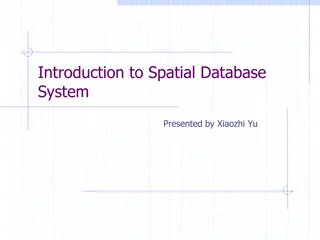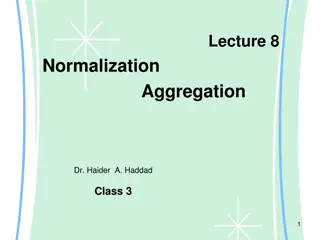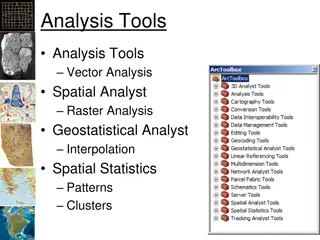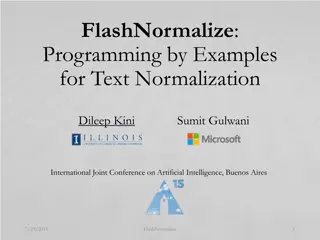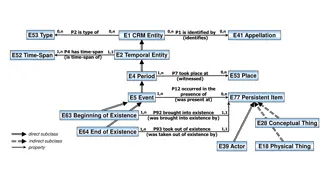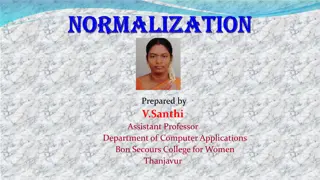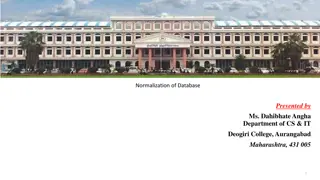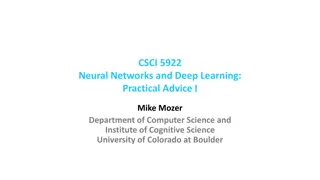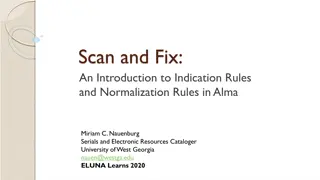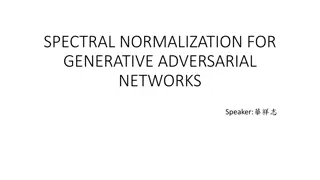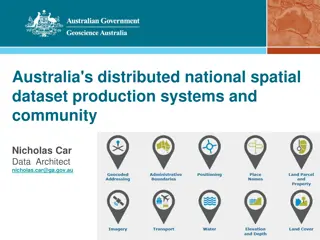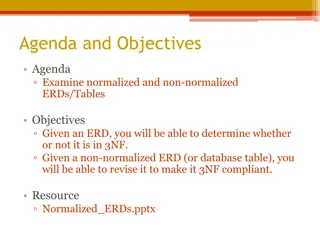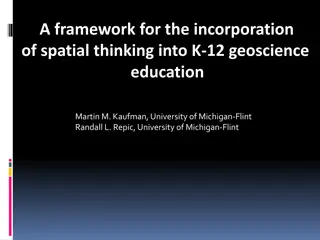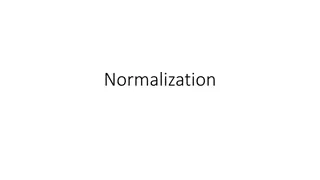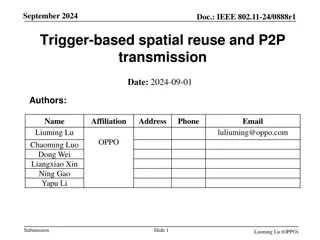fMRI Coregistration and Spatial Normalization Methods
fMRI data analysis involves coregistration and spatial normalization to align functional and structural images, reduce variability, and prepare data for statistical analysis. Coregistration aligns images from different modalities within subjects, while spatial normalization achieves precise anatomic
3 views • 35 slides
Coregistration and Spatial Normalization in fMRI Analysis
Coregistration and Spatial Normalization are essential steps in fMRI data preprocessing to ensure accurate alignment of functional and structural images for further analysis. Coregistration involves aligning images from different modalities within the same individual, while spatial normalization aim
6 views • 42 slides
Localised Adaptive Spatial-Temporal Graph Neural Network
This paper introduces the Localised Adaptive Spatial-Temporal Graph Neural Network model, focusing on the importance of spatial-temporal data modeling in graph structures. The challenges of balancing spatial and temporal dependencies for accurate inference are addressed, along with the use of distri
5 views • 19 slides
Introduction to Spatial Data Mining: Discovering Patterns in Large Datasets
Spatial data mining involves uncovering valuable patterns from extensive spatial datasets, offering insights into historical events, environmental phenomena, and predictive analytics. Examples range from analyzing disease outbreaks to predicting habitat suitability for endangered species. The applic
2 views • 20 slides
Spatial Database Systems: An Overview
This presentation by Xiaozhi Yu introduces the fundamentals of spatial database systems, covering topics such as spatial data types, relationships, system architecture, modeling, and organizing underlying spaces. It delves into the importance of integrating geometry into DBMS data models, spatial in
4 views • 30 slides
Database Normalization and Aggregation Concepts
Understanding the advantages and disadvantages of database normalization, the concept of aggregation in the ER model, and examples of creating ER diagrams using aggregation rules with related entities. Explore the benefits of smaller databases and better performance through normalization, and how ag
4 views • 11 slides
Spatial Analysis & Modeling for Spatial Planning Training in Maputo, Mozambique
Explore spatial analysis techniques for efficient route planning, site selection, pattern identification, and value prediction in the context of spatial planning. Learn about surface modeling, relationships among features, and the importance of spatial modeling in addressing geographical problems.
0 views • 27 slides
GIS Data Models for Spatial Planning Training in Maputo, Mozambique
Explore the concepts of GIS data models including vector vs. raster, spatial relationships, spatial operations, and representation of real-world entities in a spatial database. Understand how spatial data models are used to manipulate spatially-referenced information and define the spatial location
1 views • 32 slides
Spatial Autocorrelation in Geostatistical Analysis
Explore the concept of spatial autocorrelation, its implications in geostatistical analysis, and the importance of detecting and interpreting it correctly. Learn about auto-correlation, signal components, correlation significance, and measuring autocorrelation using tools like Moran's I. Gain insigh
4 views • 12 slides
Spatial Relation Switching Requirements in 3GPP NR RAN Plenary Meeting
The document discusses various spatial relation switching requirements for uplink scenarios in the 3GPP NR RAN Plenary Meeting. It covers agreement points related to UL SRS, PUCCH, P-SRS, and DL-RS, defining delay requirements and known conditions for spatial relation switching. The agreements provi
1 views • 11 slides
FlashNormalize: Programming by Examples for Text Normalization
Text normalization is essential for converting non-standard words like numbers, dates, and currencies into consistently formatted variants. FlashNormalize offers a programming-by-examples approach for accurate normalization, addressing challenges posed by traditional manual methods and statistical t
6 views • 14 slides
Temporal and Spatial Information Models
This content delves into the intricacies of temporal and spatial information models, covering concepts such as existence, presence, and spatiotemporal relationships. It explores how entities are identified, events are witnessed, and durations are defined within these models. The interplay between ti
5 views • 9 slides
Database Normalization: A Comprehensive Guide
Database normalization is a crucial process in database design to eliminate data redundancy and anomalies. This guide covers the definition of normalization, types of normalization including 1NF, 2NF, and more, along with examples and explanations on achieving each normalization form.
1 views • 22 slides
Database Normalization Techniques
Database normalization is a crucial technique for organizing data efficiently to eliminate redundancy and anomalies. It involves decomposing tables to ensure data integrity and minimize inconsistencies. Common issues without normalization include excessive memory usage and data manipulation problems
5 views • 21 slides
Enhancing Spatial Data Analysis in QGIS
Explore the integration of relational databases with QGIS to facilitate efficient spatial data analysis. Discover the importance of recognizing spatial relationships within data sets and the solutions to enhance QGIS for relational datasets. Overcome challenges and delve into the intersection and su
1 views • 25 slides
Best Practices in Neural Network Initialization and Normalization
This resource provides practical advice on input normalization, weight initialization, Xavier normalization, and Glorot/Bengio normalization in neural networks. Tips include the importance of controlling the range of net inputs, setting initial weights appropriately, and understanding the rationale
1 views • 15 slides
Batch Normalization in Neural Networks
Batch Normalization (BN) is a technique used in neural networks to improve training efficiency by reducing internal covariate shift. This process involves normalizing input data to specific ranges or mean and variance values, allowing for faster convergence in optimization algorithms. By standardizi
1 views • 18 slides
Analysis of MIMO for IMMW Transmission in IEEE 802.11-24
Proposal discusses the suitability of MIMO for IMMW transmission under different scenarios. The analysis focuses on the number of spatial streams based on channel rank and quality, recommending dual-polarization for LOS paths supporting 2 spatial streams and spatial separation for larger devices sup
0 views • 16 slides
Scan and Fix: Indication and Normalization Rules in Alma
Introduction to indication rules and normalization rules in Alma Miriam C. Nauenburg's presentation on the scan and fix workflow. Learn about creating and applying indication and normalization rules, testing rules in the Metadata Editor, and organizing rules as private or shared.
0 views • 54 slides
Spatial Multi-Attribute Decision Analysis with Incomplete Preference Information
In this study by Mikko Harju, Juuso Liesi, and Kai Virtanen from Aalto University, the focus is on spatial decision analysis for scenarios where decision alternatives have varying consequences across a geographical region. The research delves into the significance of spatial value functions in repre
1 views • 19 slides
ICAR KRISHI Geo-Portal: Spatial Agricultural Research Information
ICAR KRISHI Geo-Portal is a digital platform aiming to facilitate spatial agricultural data generation, compilation, visualization, and analysis. It hosts spatial databases, provides map services, and allows data sharing across platforms. The portal, developed using open-source technologies, offers
1 views • 32 slides
Word Normalization and Stemming in NLP
Word normalization is an essential preprocessing step in text data handling. It involves transforming text into a common form to ensure consistency in token recognition. This process helps in recognizing base forms of words through techniques like stemming and lemmatization. Normalization is crucial
1 views • 24 slides
Summer Institutes of Statistical Genetics, 2021
This comprehensive lecture discusses the importance of working on the log2 scale in gene expression profiling, explaining the benefits and practical applications of log transformation. It also delves into sample-specific normalization methods, emphasizing the transition from additive adjustments in
0 views • 14 slides
Spectral Normalization for Generative Adversarial Networks
Spectral normalization is a technique used in Generative Adversarial Networks (GANs) to address issues like non-convergence, mode collapse, and gradient problems. By normalizing the spectral norm of weight matrices, SN helps stabilize training and improve quality. Explore the benefits and applicatio
0 views • 22 slides
Summer Institutes of Statistical Genetics, 2020
Significance of working on the log2 scale in gene expression profiling, focusing on log transformation benefits and log scale insensitivity. Learn about sample-specific normalization, relative vs absolute normalization, MA plots, and various approaches to normalization techniques.
0 views • 14 slides
A Spatial Perspective
Spatial perspective is a crucial aspect in various fields, including geography, architecture, and urban planning. It involves understanding the relationships and patterns of physical spaces and their influences on human activities and environments. By adopting a spatial perspective, professionals ca
0 views • 23 slides
Text Normalization and Basic Text Processing in NLP
Regular expressions, errors, and the importance of text normalization and word tokenization in natural language processing (NLP) are explored in this comprehensive guide. Learn about the role of regular expressions, common errors in NLP tasks, and the significance of accurate text normalization for
0 views • 22 slides
Spatial Reuse in IEEE 802.11 - Overview and Proposal
This document explores the concept of spatial reuse in IEEE 802.11 standards, particularly focusing on the 11ax and 11be amendments. It discusses the benefits of spatial reuse, proposing enhancements for better utilization of spectrum and improved efficiency in wireless communications. The proposed
0 views • 6 slides
Australia's Foundational Spatial Data Framework Overview
Covering Australia's distributed national spatial dataset production systems and community involvement, the Foundational Spatial Data Framework (FSDF) is a government initiative aimed at streamlining the production of national spatial data products. Coordinated by Geoscience Australia, FSDF plays a
0 views • 40 slides
Database Normalization: Why and How, Learning Objectives, and Video Narratives
This content delves into the importance of normalization in database design, covering topics such as database efficiency, data redundancy reduction, and normalization methodologies like top-down and bottom-up approaches. Through images and narrations, it explains the significance of accurate data, s
0 views • 22 slides
Database Normalization Process Overview
Database normalization plays a vital role in optimizing data efficiency and integrity by reducing redundancy. This content covers the importance of normalization, different normalization forms, top-down and bottom-up approaches, and the practical application through ER modeling. Dive into the world
0 views • 10 slides
Understanding Geostatistical Distances Analysis in Spatial Studies
Geostatistics, a branch of statistics focusing on spatial datasets, plays a crucial role in various disciplines like geology, hydrology, and agriculture. Tobler's First Law of Geography forms the foundation of spatial analysis, emphasizing the relationship between proximity and interaction in spatia
0 views • 6 slides
Understanding Database Normalization: A Guide to 1NF, 2NF, and 3NF
This content explores the concepts of normalized and non-normalized ERDs/Tables, focusing on determining 3NF compliance. It covers key terminology like 1NF, 2NF, and 3NF, and provides insights into identifying and resolving normalization issues in database models. Practical examples and guidelines f
0 views • 26 slides
Enhancing K-12 Geoscience Education with Spatial Thinking Integration
Explore a framework for integrating spatial thinking into K-12 geoscience education, focusing on improving spatial thinking, constructive geography, and spatial-temporal primitives. Discover how a place-based curriculum can enhance spatial understanding across various science disciplines.
0 views • 26 slides
Understanding Database Normalization to Improve Data Efficiency
Learn about the significance of normalization in database management, the various normal forms, advantages of normalization, and how it helps reduce redundancy, enhance data consistency, simplify database design, improve query performance, and streamline maintenance.
1 views • 16 slides
Understanding Database Normalization Process
Database normalization is a crucial process in database development where anomalies in relations are systematically examined and corrected. It involves splitting relations to create a more structured and efficient database design. Discover the benefits of normalization, its importance in reducing da
0 views • 34 slides
Information Retrieval Techniques: Normalization and Indexing Pipeline
Learn about normalization techniques in information retrieval, including normalization to terms, handling accents in different languages, and normalizing date forms. Explore the process of indexing pipeline with examples. This lecture covers essential concepts for efficient information retrieval sys
0 views • 11 slides
Efficient Database Management Through Normalization
Database normalization is a crucial process for organizing data efficiently in databases to prevent redundancy, inconsistencies, and data loss. This method enhances database performance, accuracy, and management, making it easier to update and maintain databases effectively. Normalization ensures th
0 views • 18 slides
Understanding Data Normalization in Relational Databases
Data normalization is a crucial process in relational database design that involves breaking down larger relations into smaller ones to eliminate redundancy and data anomalies. Explore the concept of normalization and its significance in maintaining well-structured databases.
0 views • 26 slides
IEEE 802.11-24/0888r1: Coordinated Spatial Reuse for Enhanced WLAN Performance
Explore the proposal for trigger-based spatial reuse in IEEE 802.11-24/0888r1 document dated September 2024, focusing on improving WLAN reliability, throughput, and P2P operations through coordinated spatial reuse. The document discusses modes of spatial reuse, issues with PD/PSR-based operations, a
0 views • 10 slides




